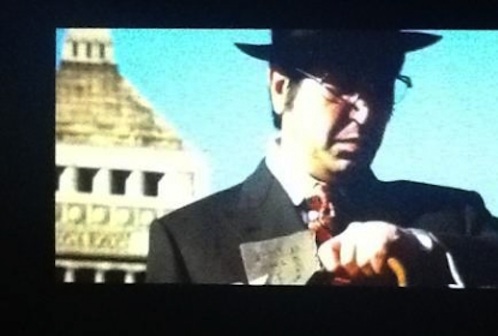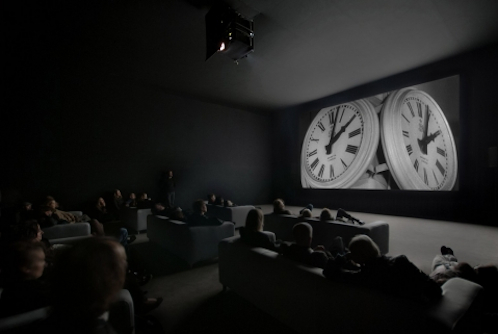The slanting light gives our sheer curtains a sheeny glow, although the fabric is matte. Outside the air is both warm and cool, just a touch hot in the sun but pleasant wherever there is shade. It is late on a Friday afternoon and the thin thrum of traffic says that people are winding up the week. Desultory, I think this mood is called. The rude cough and whine of a chainsaw starts up, but I am home with my thoughts and it’s far enough away not to break the mood.
When I was a kid, sent off to sleep in summer while there was still light, sounds from miles away floated over the windowsill as stillness settled around me. Remembering how then I could sometimes pick out faint train whistles mingling with the cricket calls, I tune in to the mix of low sounds to see what I can hear. As I listen, the buzz of the saw becomes annoyingly loud, although it is no closer than it was before.
Maybe this noticing is akin to what Terry Fox was trying to evoke in his videotaped performance Clutch (1971). The catalog for States of Mind: New California Art Circa 1970 tells us that in this video, “Fox, lying on his stomach with arms extended, follows a shaft of light as it moves across the floor, then out of reach, and finally, off screen.” I really shouldn’t be writing about it, because confronted with fifty minutes of slow-moving black and white video playing on a small monitor with no chairs in sight, I bailed.
There was a point long ago when I decided that I experienced the passage of time plenty, thank you, and I didn’t need another video artwork to draw it to my attention. In general I was in favor of the rash of irritant art that broke out during the early 1970s. But I preferred to be irritated briefly and move on, not hang around for a lengthy chafing of attention. I do recall that sometimes making that effort was worth it, that I would begin to notice myself noticing in a different way, “see” my habits of attention making the sunbeam slow or fast, the chainsaw soft or loud.

Christian Marclay, Still from The Clock, 2010
The Clock is coming to Lincoln Center in New York next week and if I could get there I would I happily camp out with a sleeping bag for the entire twenty-four hour show. But I might not need the bag, because Marclay often specifies comfortable seating (white couches at the Biennale) as part of the film installation. Is that concern for the audience decadence or progress, in the world of art-about-the-passage-of-time? I did hear more than one person say that The Clock was cool, but well . . . maybe not that deserving of the Biennale’s top honor. After all, if the speaker had the time, they could go home and do it themselves. This new age version of “my kid could do that” was to be expected, now that everyone has IMovie and streaming video. But no one complained about the couches. Creating relaxed viewing conditions was a good call; it helped establish an atmosphere of trust and openness to the event.

Christian Marclay, installation view of The Clock
So in one ring we have Terry Fox daring us to give him an hour of our time on the chance that we might come to understand something about paying attention. In the other ring, we have Christian Marclay asking for twenty-four hours, and feeding our restless attention so much material it surrenders to be carried into unfamiliar territory. I know this competition I have set up between Clutch and The Clock is a most unfair fight; the artist who is working now, building on all the artistic experiments that have gone before him, will always have the advantage. As the light shifts and the curtains become dull again, I know that I wouldn’t have appreciated Marclay’s work in the same way if I hadn’t encountered Fox’s. From his perch in history Fox shows me a richer, interconnected space of possibilities, the knowledge that a man crawling on his stomach after a sunbeam might be going to the same place as a man scrolling restlessly through film history, or a woman listening to the afternoon.
The chainsaw stops.
Exhibition Schedules
The Clock
Lincoln Center
New York, New York
July 13 – August 1, 2012
Tuesdays–Thursdays, 8:00 am–10:00 pm
Runs continuously from Fridays at 8:00 am through Sundays at 10:00 pm
Power Plant Contemporary Art Centre
Toronto, Ontario, Canada
September 21 – November 25, 2012
State of Mind: New California Art Circa 1970
Morris and Helen Belkin Art Gallery
Vancouver, British Columbia
9/28/12 – 12/9/12
SITE Sante Fe
Sante Fe, New Mexico
2/23/13-5/20/13
The Bronx Museum of the Arts
Bronx, New York
6/23/13 – 9/8/13
